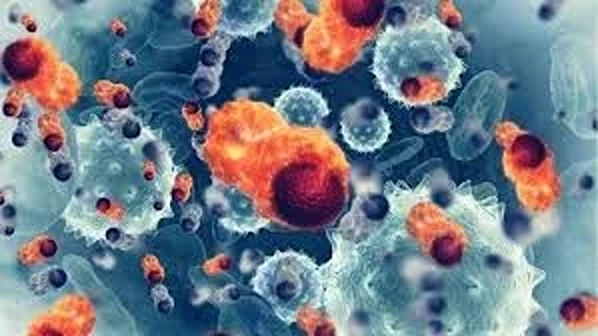Introduction
Nanoparticles have now been used by researchers at the Indian Institute of Science (IISc) to discover and eradicate cancer cells. They have made cross-breed nanoparticles made of gold and copper sulfide that can distinguish disease cells with the assistance of sound waves and kill them utilizing heat. This clever methodology depends on the review distributed in ACS Applied Nano Materials.
It is accepted that early recognition and therapy are significant for the fight against malignant growth treatment. Getting a diagnosis early on in this disease is essential. Copper sulfide nanoparticles recently got the titles for their application in malignant growth analysis while gold nanoparticles have shown anticancer impacts. The researchers at IISc have now joined both to shape half and half nanoparticles in their most recent review of ACS Applied Nano Materials.
Jaya Prakash says that these hybrid nanoparticles can kill cancer cells by absorbing light and producing heat during the process. These nanoparticles additionally produce singlet oxygen particles that are harmful to the cells. The blend of both these components will be deadly for the growth cells.
The current techniques, for example, CT and X-ray filters require prepared radiology experts to translate the pictures yet the photoacoustic properties of these particles can furnish better pictures with high goals. It ingests light and produces ultrasound waves which gives a clearer and exact depiction of the malignant growth cells. The sweeps created from the ultrasound waves can likewise quantify the oxygen immersion in the growth thus supporting the location of the dangerous cells.
“It can likewise be coordinated with the current frameworks of location or treatment,” said Ashok M Raichur, Teacher at the Branch of Material Designing during the public statement. He is likewise one of the comparing creators of the paper distributed.
In the momentum review, the analysts tried their nanoparticles on lung and cervical malignant growth cell lines in the lab. The researchers are presently wanting to take the outcomes forward for clinical turn of events.
Conclusion : Future of Cancer Treatment with Nanoparticles
Nanoparticles are tiny particles that can be engineered to deliver drugs or genes to specific cells in the body. They have the potential to revolutionize cancer treatment by targeting tumor cells while sparing healthy ones. In this article, we discussed how nanoparticles can be used to target lung and cervical cancer cells, two of the most common and deadly types of cancer. We also highlighted some of the challenges and opportunities in nanoparticle-based cancer therapy, such as safety, efficacy, and scalability. Nanoparticles are still in the early stages of clinical development, but they offer a promising avenue for unlocking the future of cancer treatment.
FAQs
Q: What are nanoparticles and how do they work?
A: Nanoparticles are particles that have at least one dimension between 1 and 100 nanometers (a nanometer is one billionth of a meter). They can be made of different materials, such as metals, polymers, lipids, or proteins. Nanoparticles can be designed to carry drugs or genes and deliver them to specific cells in the body. They can also be modified to have certain properties, such as size,
shape, charge, or surface chemistry, that affects their interaction with biological systems.
Q: How can nanoparticles target lung and cervical cancer cells?
A: Nanoparticles can target lung and cervical cancer cells by exploiting their unique features, such as receptors, metabolism, or microenvironment. For example, nanoparticles can be coated with antibodies or ligands that bind to receptors that are overexpressed on tumor cells, such as EGFR or HER2. Nanoparticles can also be loaded with drugs or genes that interfere with the growth or survival of tumor cells, such as chemotherapy agents or siRNA. Nanoparticles can also be triggered by external stimuli, such as light, heat, or magnetic fields, to release their cargo at the desired location.
Q: What are the advantages of nanoparticle-based cancer therapy?
A: Nanoparticle-based cancer therapy has several advantages over conventional cancer therapy, such as:
– Enhanced specificity: Nanoparticles can target tumor cells while minimizing damage to healthy cells, reducing side effects, and increasing efficacy.
– Controlled release: Nanoparticles can control the amount and timing of drug or gene delivery, improving the pharmacokinetics and pharmacodynamics of the therapy.
– Multifunctionality: Nanoparticles can combine different functions, such as imaging, diagnosis, and therapy, in one platform, enabling personalized and precision medicine.
Q: What are the challenges of nanoparticle-based cancer therapy?
A: Nanoparticle-based cancer therapy also faces several challenges, such as:
– Safety: Nanoparticles may have unknown or unpredictable effects on the body, such as toxicity, immunogenicity, or biodistribution. Nanoparticles may also accumulate in certain organs or tissues, such as the liver, spleen, or brain, causing unwanted effects or complications.
– Efficacy: Nanoparticles may encounter various barriers in the body, such as the blood-brain barrier, the extracellular matrix, or the tumor microenvironment, that limit their access or delivery to the target cells. Nanoparticles may also be cleared by the immune system or the kidneys before reaching their destination.
– Scalability: Nanoparticles may require complex and costly synthesis, characterization, and optimization processes, which may limit their large-scale production and clinical translation.
Q: What are the future directions of nanoparticle-based cancer therapy?
A: Nanoparticle-based cancer therapy is still in the early stages of clinical development, but it has a bright future ahead. Some of the future directions of nanoparticle-based cancer therapy is:
– Developing novel nanoparticles with improved properties, such as biodegradability, biocompatibility, or stimuli-responsiveness.
– Exploring new targets and mechanisms for nanoparticle-mediated cancer therapy, such as epigenetics, immunotherapy, or stem cells.
– Combining nanoparticles with other modalities of cancer therapy, such as surgery, radiation, or immunotherapy, to achieve synergistic or complementary effects.
– Evaluating the long-term safety and efficacy of nanoparticles in animal models and human trials, as well as the ethical and regulatory issues involved in nanoparticle-based cancer therapy.




